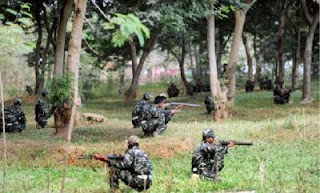White House officials said that in a meeting with Pentagon chiefs Mr Obama had made clear he wants his decision on troop reinforcements to offer a strong suggestion of when and how responsibility for security would be turned over to the Afghans.
After two months of discussions with his advisers he rejected all four options they had touted on the number of troops to be sent, in a surprise move that risked provoking further allegations of “dithering”.
While he is still expected to announce that he is sending reinforcements, Mr Obama insisted that a broad framework for handing over control of security to the Afghan army is written in, as he sought to warn Afghan leaders - and reassure the US public - that the mission is not "open-ended".
Robert Gibbs, the White House spokesman, said on board Air Force One, said: “The president believes that we have been there for eight years, and we're not going to be there forever. And it's important to fully examine not just how we're going to get folks in but how we're going to get folks out.”
The move followed a forceful intervention about the troop build-up from General Karl Eikenberry, the US ambassador to Kabul.
In two classified cables and comments he made to Mr Obama by video link late on Wednesday, he came out firmly against bolstering the American presence unless President Hamid Karzai seriously addresses corruption, and argued that more US troops would only make the Afghans more dependent.
As the US commander in Afghanistan in 2006 and 2007, Gen Eikenberry’s views will carry extra weight, as well as annoying his successor, Gen Stanley McChrystal, who has requested a “surge” of up to 40,000 troops.
Mr Obama’s aides said he made clear he wants his long-awaited decision on troop reinforcements to offer a strong suggestion of when and how responsibility for security would be turned over to the Afghans.
Mr Obama is now expected to opt for at least 20,000 extra troops, many of whom would be engaged in training Afghan recruits, when he finally makes his announcement after returning from a tour of Asia next week.
“The president believes that we need to make clear to the Afghan government that our commitment is not open-ended,” said a White House official after the meeting.
“After years of substantial investments by the American people, governance in Afghanistan must improve in a reasonable period of time to ensure a successful transition to our Afghan partner.”
Tensions between the White House and the Pentagon over the deployment have already bubbled to the surface. Senior presidential advisers have accused generals of leaking the misinformation that Mr Obama has all but decided to dispatch more than 34,000 additional troops, in a bid to force his decision. There are currently 68,000 US military personnel in Afghanistan.
Developments in Washington and recent comments by Gordon Brown suggest that Nato allies are moving towards a twin approach of deepening commitment - particularly on training Afghan security forces - while increasing pressure on Kabul to assume responsibility in specific locations at the earliest possible opportunity.
Anders Fogh Rasmussen, the Nato Secretary-General, said yesterday after a meeting with the Prime Minister in London that “we can and should start next year to hand lead responsibility to Afghan forces in a coordinated way through Nato where conditions permit”.
Mr Brown said earlier this week that handovers in the volatile southern province of Helmand, where most of Britain’s 9,000 troops are based, could begin as early as June.
“Our exit strategy is a function of Afghanization,” said Simon Lewis, Mr Brown’s spokesman, who stressed that handing over responsibility for security would “not necessarily” mean any immediate reduction in troop numbers.
Both London and Washington have sharpened the tone of their rhetoric against Mr Karzai, who was found to have committed major electoral fraud in the August election but is nonetheless forming a new government.
Hillary Clinton, the US Secretary of State, yesterday reiterated US concern about Afghanistan’s “corruption, lack of transparency, poor governance [and] absence of the rule of law”.
Mr Karzai’s spokesman said the government was committed to tackling corruption, but put some of the blame on the West.
A palace spokesman said: “We’ve pledged to the international community to further intensify our efforts against corruption. We are serious.
“At the same time, we want the international community to do more to eliminate corruption in spending aid money. We want the international community to eliminate corruption that exists in the contract systems.”
Watch: Keke Palmer investigates murder house in 'The 'Burbs'
-
Peacock released the trailer for "The 'Burbs" on Friday. The series,
starring Keke Palmer in an update on the 1989 movie, premieres Feb. 8.
25 minutes ago












